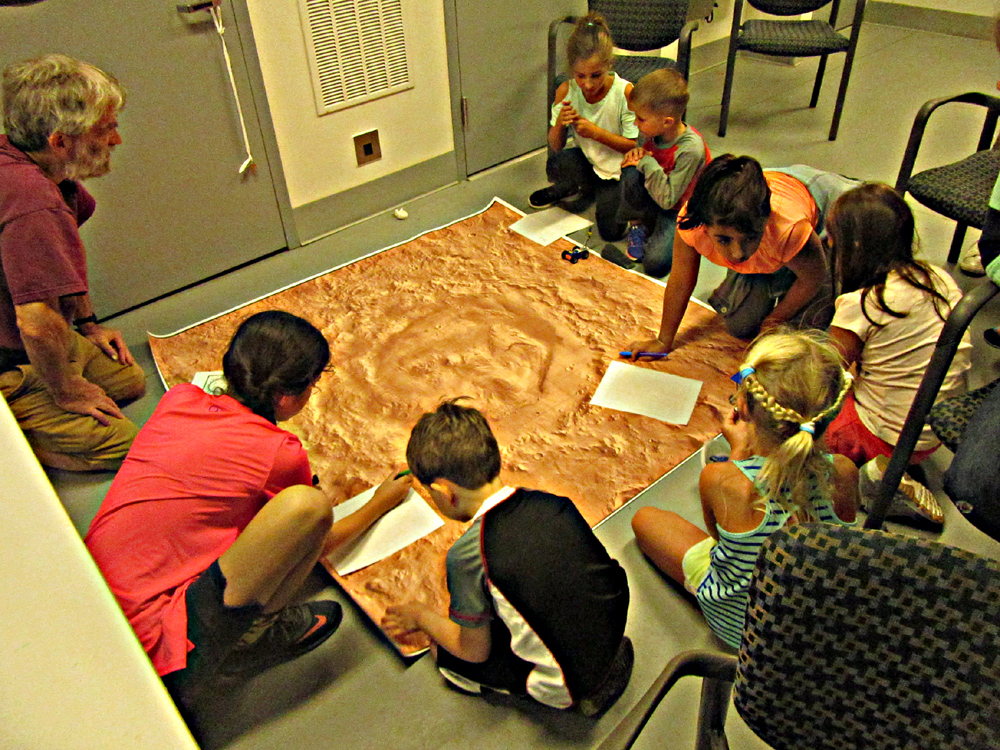 Bill Burton with students at Turner Farm earlier the year. As safety guidelines permit, Observatory Park at The Turner Farm will again be offering astronomy-themed classes on Mars, stars and constellations, and other celestial events. Check Parktakes online and the Analemma Society website for updates on programming. Bill Burton with students at Turner Farm earlier the year. As safety guidelines permit, Observatory Park at The Turner Farm will again be offering astronomy-themed classes on Mars, stars and constellations, and other celestial events. Check Parktakes online and the Analemma Society website for updates on programming. |
Local students will be taking special interest in a NASA Mars mission this summer. A student from Lake Braddock Secondary School named the U.S. rover called Perseverance that will land on the planet’s surface, and students in a Park Authority science program worked on a mock-up of a Mars mission of their own.
Before astronomy programs at The Turner Farm observatory were canceled because of the COVID-19 pandemic, a group of students spent time studying Mars with an instructor from the Analemma Society. Bill Burton helped the students develop a plan for exploring a crater on Mars by using small rover models that the students made themselves. It gave the students a feel for creating a mission plan and was a great warm-up for the real NASA mission that launches in July 2020. Timing is everything with these Mars missions. The Analemma Society’s Shawn Dilles (who volunteers and teaches classes at Turner Farm provides the details:
"Every two years, NASA and a few other national space agencies launch new probes toward the planet Mars to join the other spacecraft already in operation there to explore the red planet. The timing of the launches is not a coincidence. Earth and Mars both orbit the sun in the same direction, but Earth completes an orbit in just over 365 days (one Earth Year). Mars is further from the sun, and traveling slower completes one orbit every 687 days (one Mars Year)."
"Because they are travelling at different speeds through their orbits, the distance between Earth and Mars varies throughout the Martian Year. At the closest point, Earth is positioned between Mars and the Sun – a time called opposition since Mars is opposite the Sun from Earth. Opposition between Earth and Mars occurs every two years and 50 days. Earth and Mars are farthest apart when on opposite sides of the sun from each other, and this is known as a conjunction."
"Observers on Earth are able to track the time when Earth “laps”’ Mars when travelling around the sun. Planets generally move from east to west relative to the background constellations. For a brief time before, during and after opposition, Mars will appear to slow, stop and move backwards toward the west. This apparent retrograde motion of Mars is because Earth appears to catch up to and then pass Mars. In 2020, Mars will be in the constellation Pisces, and the retrograde motion will occur from September 9 to November 14."
"Rocket scientists use the difference in orbital positions and speeds to advantage. The goal is to minimize the amount of fuel and time needed to get to Mars, in order to allow the most payload possible to be flown. The spacecraft are aimed at a point ahead of the where Mars is in its orbit, so that by the time they arrive, Mars will have “caught up” to this position."
"The United States, China, and the United Arab Emirates have each scheduled launches to Mars in July 2020. If successful, these spacecraft will join the Curiosity Rover and six orbiting spacecraft (Mars Odyssey, Mars Express, Mars Reconnaissance Orbiter, Mars Orbiter Mission, MAVEN and the Trace Gas Orbiter) at the planet."
"NASA’s Mars 2020 mission be launched around July 17, and it is based on the Mars Science Laboratory design. It will include an improved rover called “Perseverance” that was named Alexander Mather, a 7th grader at Lake Braddock Secondary School in Burke, as part of a NASA naming contest. The mission will also carry a small helicopter named “Ingenuity” -- the first aircraft sent by Earth to another world. Vaneeza Rupani, an 11th grade student from Alabama, suggested the name Ingenuity. The helicopter will fly ahead of the rover to provide mission planners with the data on the best routes to take. The exploration goals are to explore the area around Jezero Crater, believed to have once been an ancient lakebed."
"China’s Tianwen-1 lander and a rover are scheduled to land in Utopia Planitia to seek evidence of past life on Mars and study the planet’s surface and environment. A Chinese orbiter will study the Martian atmosphere, ionosphere, ice and surface topography. The United Arab Emirates orbiter will study the Martian atmosphere and weather, including dust storms on the planet."

